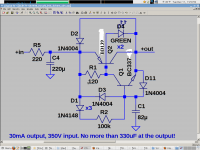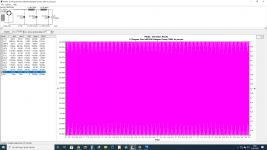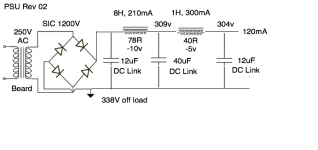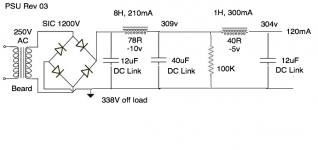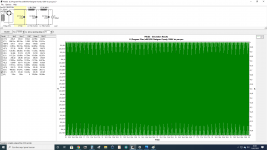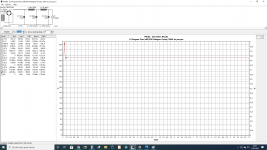elvee, that sure makes valve rectifiers an interesting proposition. I’m currently using an AZ1 also, and was toying with replacing it with SiC diodes. i might not bother now…
are these switching benefits likely to carry over into other applications, such as the valve dac: https://www.diyaudio.com/community/threads/valve-dac-from-linear-audio-volume-13.308860/ ?
are these switching benefits likely to carry over into other applications, such as the valve dac: https://www.diyaudio.com/community/threads/valve-dac-from-linear-audio-volume-13.308860/ ?
Change in voltage amplitude wrt time is just a waveform which represents the recovery characteristics of a switch wrt time.
Tubes do well here. As noted. As known. TV damper diodes (6CJ3 etc) do better than most - and that they are just a couple of dollars each.
It comes down to heater supply, voltage drop and the space to accomodate them physically on the chassis.
Build it!
Tubes do well here. As noted. As known. TV damper diodes (6CJ3 etc) do better than most - and that they are just a couple of dollars each.
It comes down to heater supply, voltage drop and the space to accomodate them physically on the chassis.
Build it!
This particular design doesn't seem to use diodesare these switching benefits likely to carry over into other applications, such as the valve dac: https://www.diyaudio.com/community/threads/valve-dac-from-linear-audio-volume-13.308860/ ?
Yeah, I was just wondering if the switching characteristics of tubes vs solid state carries over to other areas and topologies.This particular design doesn't seem to use diodes
In low-voltage logic, fast Si or small schottky diodes are very good, and their technological flaws only have a minimal effect.
Directly substituting a vacuum diode would not be possible anyway, due to the much higher forward drop.
In purely tube logic circuits, like the early computers, it is possible but these circuits are inherently slow compared to transistor ones due to the high voltages and low currents: the slightest parasitic capacitance has a disproportionate impact
Directly substituting a vacuum diode would not be possible anyway, due to the much higher forward drop.
In purely tube logic circuits, like the early computers, it is possible but these circuits are inherently slow compared to transistor ones due to the high voltages and low currents: the slightest parasitic capacitance has a disproportionate impact
I've been trying out a SIC diode bridge in my driver stage so far, and now tried it out in the SE 6C4C output stage in place of a 5U4. In listening tests I'm finding it hard to find a preference.
The 5U4 is a fuller sound, more rounded, and smoother. The DIC diodes are "faster" sounding - better timing and more detail. This alone makes me want to prefer them. The sound is lighter but a little less smooth.
At first listen I like the diodes, but I would like the smoothness of the 5U4. If I could get the diodes to sound as smooth as the tube rectifier I think I'd go with them, so I'll see if adding chokes and playing around with the caps helps. PSU is C (12uF DC Link) > L (8H, 210mA, large) > C ( Kemet electrolytic 68uF, 550V) > R 750R > C (12uF DC Link).
Any suggestions? I haven't looked into shunt regs yet.
The 5U4 is a fuller sound, more rounded, and smoother. The DIC diodes are "faster" sounding - better timing and more detail. This alone makes me want to prefer them. The sound is lighter but a little less smooth.
At first listen I like the diodes, but I would like the smoothness of the 5U4. If I could get the diodes to sound as smooth as the tube rectifier I think I'd go with them, so I'll see if adding chokes and playing around with the caps helps. PSU is C (12uF DC Link) > L (8H, 210mA, large) > C ( Kemet electrolytic 68uF, 550V) > R 750R > C (12uF DC Link).
Any suggestions? I haven't looked into shunt regs yet.
A common trick in guitar amps is to add resistors in series with silicon rectifiers to emulate he sag you get with tube rectifiers. You could even add a switch to flip between the two.
Cheers
Ian
Cheers
Ian
A common trick in guitar amps is to add resistors in series with silicon rectifiers to emulate he sag you get with tube rectifiers. You could even add a switch to flip between the two. Cheers
Ian
Thanks Ian. Where exactly are you putting these resistors in relation to the diode bridge, and what value?
I have 600V SIC diodes as well which I've made into a bridge with 8 plus 560K equalising resistors - would that have a similar effect? Haven't tried them yet.
With a 5U4 you've got a soft "saggy" rectifier. In the case of a class A amp, that sag is constant. In a class AB or B amp, that sag varies with the output power and results in a compressed output. It also can't clip as hard because the source impedance of the PSU is higher. Some people refer to this as "smoother"...
I don't think you want sag - the attraction of Schottky diodes and DC Link capacitors is a resilient DC supply.
You can try adding LC filtering, but low-L, low-R chokes. Or, a cap multiplier.
Adding more capacitance will help too, I suspect.
You can try adding LC filtering, but low-L, low-R chokes. Or, a cap multiplier.
Adding more capacitance will help too, I suspect.
Agreed! That's kind of what I was saying - I think he likes the SiC diodes because they don't sag as much as a tube rectifier in the same duty.
HV cap multiplier like this? If I remember correctly Calvin design, thanks.I don't think you want sag - the attraction of Schottky diodes and DC Link capacitors is a resilient DC supply.
You can try adding LC filtering, but low-L, low-R chokes. Or, a cap multiplier.
Adding more capacitance will help too, I suspect.
Attachments
Last edited:
I don't think you want sag - the attraction of Schottky diodes and DC Link capacitors is a resilient DC supply. You can try adding LC filtering, but low-L, low-R chokes. Or, a cap multiplier. Adding more capacitance will help too, I suspect.
Thanks, Rod, that was pretty much my plan. So I've added 68uF and a 158T choke, 1H/300V and lastly a 12uF DC Link. Not a big difference, but I think slightly smoother.
I have Kemet 68uF electrolytics and 12uF DC link caps I can use. I'm wondering how to distribute them in the PSU. To my ears the electrolytics are more neutral and detailed, maybe faster? The DC Link caps sound more rounded and either smoother or just a trifle softer in the treble. This is what I have right now.
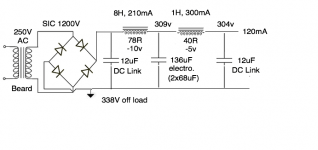
Thanks for that, Merlin. It didn't sound so good, so I took out all the electrolytics and just used DC Link caps. So I now have the following which is smoother sounding. The electrolytics seemed to add detail but also an edge, but if there was ringing the actual design may be what is wrong. Try this one. Feel free to make suggestions.
Attachments
- Home
- Amplifiers
- Tubes / Valves
- Tube rectifier versus 1200v SIC diodes?
